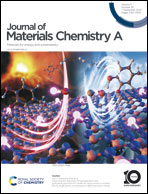Concurrent alloying and vacancy engineering for intensifying hydrogen spillover towards alcohol–water co-electrolysis†
Abstract
Overcoming the thermodynamic and kinetic barrier of the hydrogen spillover process is of vital significance for improving the electrocatalytic hydrogen evolution reaction (HER) activity of the metal-supported binary catalysts. Here, we innovatively develop an alloying and vacancy engineering strategy to synergistically narrow the work function difference between the metal and support (ΔΦ) and sequentially intensify the effective interfacial hydrogen transfer by constructing a metallene-like PdRu–RuO2 heterostructure with a well-designed PdRu alloy phase and abundant oxygen vacancies. Experimentally, the optimal PdRu–RuO2 heterostructures can concurrently drive hydrogen production and the alcohol oxidation reaction (AOR) by delivering ultrahigh catalytic activity, which enables them to act as promising bifunctional electrocatalysts for hydrogen production from an aqueous solution of alcohols. Based on a combination of theoretical simulations and experiments, it is rationalized that the formation of the heterostructure of PdRu alloy and oxygen-vacancy-enriched RuO2 synergistically decreases the ΔΦ and facilitates interfacial hydrogen spillover, endowing the PdRu alloy with efficient hydrogen adsorption and RuO2 with facile hydrogen desorption.



 Please wait while we load your content...
Please wait while we load your content...